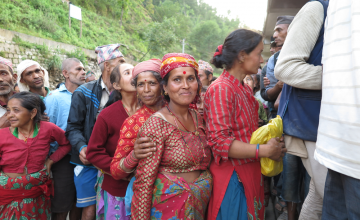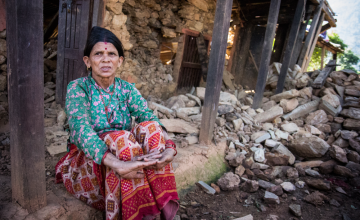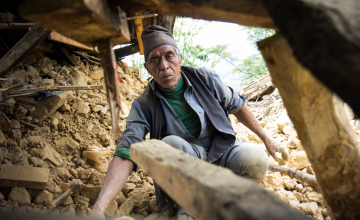
Read our 2024 annual report

Knowledge Hub
Concern Worldwide's #NepalEarthquake response explained

Co-ordinating an emergency response is a difficult and challenging task. Concern is working with local partner organisations, Rural Reconstruction Nepal and Nepal Water for Health, to assess the situation in Nepal and to distribute aid as quickly as possible to those who need it most. Here are answers to some common questions that have arisen as a result of the 7.8 magnitude Nepal earthquake.
Where are you working and how is this decided?
Concern is focussed on reaching vulnerable and isolated communities that need assistance in the wake of this terrible disaster.
Remote and rural homes in Nepal tend to be made with stones and mud, leaving them completely unprotected against an earthquake of such magnitude. This has led to the complete destruction of homes and livelihoods across many remote districts.
Reaching these communities is challenging, as many of the worst affected areas affected have either been cut off or are extremely difficult to access due to landslides and severely damaged infrastructure.

In order to reach the communities that most need help, we have partnered with local organisations and are coordinating our efforts with other international NGOs, the UN, and the district disaster relief committees set up by the Government of Nepal.
We are currently focussed on distributing aid to 14,000 families in three of the ten worst affected districts: Sindhulpalchowk, Dolakha and Sindhuli.
Why is it taking so long for aid to reach the people of Nepal?
We have started moving supplies from India. This process is slow due to a combination of damaged infrastructure, heavy congestion on the India-Nepal border, low road density in Nepal and the closing of Kathmandu airport to large planes. Landslides in some regions have rendered it almost impossible for aid to be brought into the country via helicopter.

Concern is working with two experienced local partner organizations, Rural Reconstruction Nepal and Nepal Water for Health to distribute relief items. When our relief items are in Nepal in the coming days, our partners will be essential in getting it immediately to those who need it most.
What do you do to help the people worst affected?
Shelter, water and sanitation are our first priorities. Initially, we will be delivering emergency kits to 14,000 families including tents, jerry cans, blankets, sleeping mats, hygiene kits (soap, toilet paper, razors, hygiene pads, toothpaste etc.), plastic sheets, rope, water purification tablets and water jugs. Once this is implemented our next priority will be to help people quickly recover their livelihoods through access to cash and rebuilding any damaged water and sanitation infrastructure.

Why should I donate to Concern?
Concern is on the ground in Nepal and has set up networks with local partner organisations which will ensure that emergency aid reaches the most vulnerable people as quickly as possible. As an organisation we are extremely experienced in this area. We were early responders in a number of earthquakes in the region and globally, including the 2005 Pakistan earthquake and the 2010 Haiti earthquake. As with every response, our priority will be to reach the people who are in the most vulnerable and isolated communities. After we distribute immediate relief, we will then work hand-in-hand with communities to help them rebuild their livelihoods.

Thank you
Your generosity has made it possible for us to move quickly to deliver and purchase relief supplies. It will also allow us to continue to help families prepare for the rainy season and eventually rebuild their homes and livelihoods. So far, Concern has raised more than €450,000 from the Irish public.
Follow Concern
Keep up to date with all of Concern's work by following us on Instagram.



